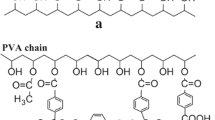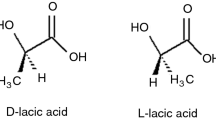Abstract
A series of novel copolymers were successfully synthesized by ring-opening polymerization (ROP) of 3(S)-methyl-morpholine-2,5-dione (MMD) and 5-methyl-5-benzyloxycarbonyl-1,3-dioxan-2-one (MBC) using stannous octoate as catalyst. The copolymers were characterized by means of 1H-NMR and FT-IR spectroscopy. Gel permeation chromatography (GPC) test shows that the average-number relative molecular mass and average-weight relative molecular mass slightly increase with the increase of MBC content in feed. The results of differential scanning calorimetry (DSC) demonstrate that the glass transition temperature of copolymers increases with the increase of MBC content in copolymers. The copolymers of MMD and MBC are amorphous copolymers, as indicated by DSC results, while the homopolymer of MMD is semicrystalline.
Similar content being viewed by others
References
Lutz J F, Andrieu J, Uzgun S et al. Biocompatible, thermoresponsive, and biodegradable: Simple preparation of “all-in-one” biorelevant polymers[J]. Macromolecules, 2007, 40(24): 8540–8543.
Green J J, Zhou B Y, Mitalipova M M et al. Nanoparticles for gene transfer to human embryonic stem cell colonies[J]. Nano Letters, 2008, 8(10): 3126–3130.
Tian Jing, Feng Yakai, Xu Yongshen. Ring opening polymerization of D,L-lactide on magnetite nanoparticles[J]. Macromolecular Research, 2006, 14(2): 209–213.
Lim S K, Lee S I, Jang S G et al. Synthetic aliphatic biodegradable poly(butylene succinate)/MWNT nanocomposite foams and their physical characteristics[J]. Journal of Macromolecular Science(Part B), 2011, 50(6):1171–1184.
Feng Yakai, Lu Jian, Behl M et al. Progress in depsipeptide-based biomaterials[J]. Macromolecular Bioscience, 2010, 10(9): 1008–1021.
Lin Jiaping, Zhu Jiaqi, Chen Tao et al. Drug releasing behavior of hybrid micelles containing polypeptide triblock copolymer[J]. Biomaterials, 2009, 30(1): 108–117.
Hamidi M, Azadi A, Rafiei P. Hydrogel nanoparticles in drug delivery[J]. Advanced Drug Delivery Reviews, 2008, 60(15): 1638–1649.
Feng Yakai, Guo Jintang. Biodegradable polydepsipeptides[J]. International Journal of Molecular Sciences, 2009, 10(2): 589–615.
Borner H G. Functional polymer-bioconjugates as molecular LEGO bricks[J]. Macromolecular Chemistry and Physics, 2007, 208(2): 124–130.
Kim J, Magno M H R, Alvarez P et al. Osteogenic differentiation of pre-osteoblasts on biomimetic tyrosine-derived polycarbonate scaffolds[J]. Biomacromolecules, 2011, 12(10): 3520–3527.
Battig A, Hiebl B, Feng Yakai et al. Biological evaluation of degradable, stimuli-sensitive multiblock copolymers having polydepsipeptide- and poly(ɛ-caprolactone) segments in vitro[J]. Clinical Hemorheology and Microcirculation, 2011, 48(1–3): 161–172.
Abayasinghe N K, Perera K P U, Thomas C et al. Amidomodified polylactide for potential tissue engineering applications[J]. Journal of Biomaterials Science Polymer Edition, 2004, 15(5): 595–606.
Katsarava R, Beridze V, Arabuli N et al. Amino acid-based bioanalogous polymers: Synthesis, and study of regular poly(ester amide)s based on bis(α-amino acid) α, ω-alkylene diesters, and aliphatic dicarboxylic acids[J]. Journal of Polymer Science (Part A): Polymer Chemistry, 1999, 37(4): 391–407.
Schakenraad J M, Nieuwenhuis P, Molenaar I et al. In vivo and in vitro degradation of glycine/D,L-lactic acid copolymers[J]. Journal of Biomedical Materials Research, 1989, 23(11): 1271–1288.
Wang Dong, Feng Xinde. Copolymerization of ɛ-caprolactone with (3S)-3-[(benzyloxycarbonyl)methyl] morpholine-2,5-dione and the 13C NMR sequence analysis of the copolymer[J]. Macromolecules, 1998, 31(12): 3824–3831.
Gilon C, Klausner Y. A novel method for the facile synthesis of depsipeptides[J]. Tetrahedron Letters, 1979, 20(40): 3811–3814.
Chorev M, Willson C G, Goodman M. A general approach to retro-isomeric linear peptide synthesis[J]. Journal of the American Chemical Society, 1977, 99(24): 8075–8076.
Katakai R, Kobayashi K, Yamada K et al. Synthesis of sequential polydepsipeptides utilizing a new approach for the synthesis of depsipeptides[J]. Biopolymers, 2004, 73(6): 641–644.
Barrera D A, Zylstra E, Lansbury E et al. Copolymerization and degradation of poly(lactic acid-colysine)[J]. Macromolecules, 1995, 28(2): 425–432.
Zhu Caihong, Chen Qiang, Tian Weiwei et al. Synthesis and characterization of copolymers with 3-methylmorpholine-2,5-dione and L-lactide[J]. Materials Review, 2004, 18(7): 96–98 (in Chinese).
Helder J, Kohn F E, Sato S et al. Synthesis of poly [oxyethylidenecarbonylimino (2-oxoethylene)][poly (glycine-D, L-lactic acid)] by ring opening polymerization[J]. Macromolecular Rapid Communications, 1985, 6(1): 9–14.
Feng Yakai, Klee D, Höcker H. New biomaterial: Triblock copolymers of poly [3(S)-isobutyl-morpholine-2,5-dione]-poly(ethylene oxide)[J]. Materialwissenschaft und Werkstofftechnik, 1999, 30(12): 862–868 (in German).
Kricheldorf H R, Jenssen J. Polylactones. 16. Cationic polymerization of trimethylene carbonate and other cyclic carbonates[J]. Journal of Macromolecular Science(Part A): Chemistry, 1989, 26(4): 631–644.
Kricheldorf H R, Weegen-Schulz B. Polymers of carbonic acid. 11. Reactions and polymerizations of aliphatic cyclocarbonates with boron halogenides[J]. Macromolecules, 1993, 26(22): 5991–5998.
Kricheldorf H R, Hauser K. Polylactones, 45. Homo- and copolymerizations of 3-methylmorpholine-2, 5-dione initiated with a cyclic tin alkoxide[J]. Macromolecular Chemistry and Physics, 2001, 202(7): 1219–1226.
Author information
Authors and Affiliations
Corresponding author
Additional information
Supported by Chinese Program for New Century Excellent Talents in University “NCET”, Ministry of Education of P.R. China(No. 2008DFA51170).
FENG Yakai, born in 1966, male, Dr, Prof.
Rights and permissions
About this article
Cite this article
Feng, Y., Chen, C., Zhang, L. et al. Synthesis and characterization of novel copolymers based on 3(S)-methyl-morpholine-2,5-dione. Trans. Tianjin Univ. 18, 315–319 (2012). https://doi.org/10.1007/s12209-012-1864-9
Accepted:
Published:
Issue Date:
DOI: https://doi.org/10.1007/s12209-012-1864-9




